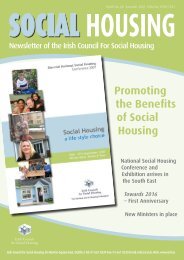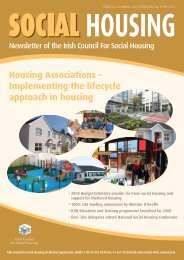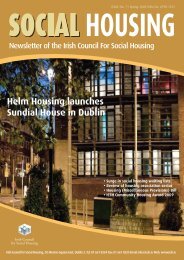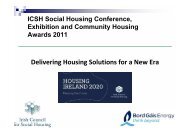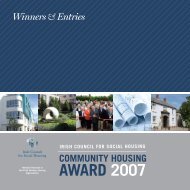National Housing Strategy for People with a Disability 2011 - 2016
National Housing Strategy for People with a Disability 2011 - 2016
National Housing Strategy for People with a Disability 2011 - 2016
You also want an ePaper? Increase the reach of your titles
YUMPU automatically turns print PDFs into web optimized ePapers that Google loves.
‘Accommodation tends to be in open wards and dormitories offering little privacy toresidents who are likely to spend much of their lives there…Even <strong>for</strong> the younger and moremobile residents, there are few opportunities to leave the confines of the home and thisserves to heighten boredom and frustration…Residents have little if any say in the day today operation of what <strong>for</strong> many is the only homes they will ever know.’ 18Since 1990 in particular, the movement towards community inclusion <strong>for</strong> people <strong>with</strong>disabilities has had a strong impetus, drawing especially on American influence, and theemergence of the disability rights movement in Ireland and internationally. The advent ofCentres <strong>for</strong> Independent Living in the early 1990s and the beginning of availability ofpersonal supports spearheaded the movement by people <strong>with</strong> physical disabilities to takecontrol over their lives and choices, including their choice of accommodation.The redirection of policy towards community based living arrangements was clearly evidentin the 1990s. In 1990, The Report of the Review Group on Mental Handicap Services, ‘Needsand Abilities’ made comprehensive recommendations on the need to move from largecongregated settings to domestic scale accommodation and access to community basedhealth services. It recommended that families should be supported to enable adults <strong>with</strong>intellectual disabilities to live at home; where a person must leave home, the substitutehome should have all the characteristics of a good family home, other family care schemessuch as adult foster care should be initiated. The Report proposed that large numbers ofhighly dependent intellectually disabled people should not be placed in one location. Smallgroup homes should be provided where a small number of adults are supported to share ahome, and also that existing residential centres that were not domestic in scale should bediscontinued as soon as possible, and replaced <strong>with</strong> appropriate provision. 19In 1996, “Towards an Independent Future”, the Report of the Review Group on Health andPersonal Social Services <strong>for</strong> <strong>People</strong> <strong>with</strong> Physical and Sensory Disabilities, maderecommendations about residential provision. As the extract below shows, this Review Bodysignalled a move away <strong>for</strong>m large institutions, towards small living units and use ofmainstream housing provision:‘Developments of new homes and independent living should be located in urban areasor easily accessible to retail and leisure facilities.’‘Each health board, in consultation <strong>with</strong> the co-coordinating committee, should examinethe viability of establishing in its area small independent domestic dwellings <strong>with</strong>support …Health Boards and voluntary bodies providing services to people <strong>with</strong>disabilities should liaise closely <strong>with</strong> Social <strong>Housing</strong> organisations and local authorities toensure that an adequate number of accessible houses is available to people <strong>with</strong>disabilities who wish to pursue this option.’ 20 .166



